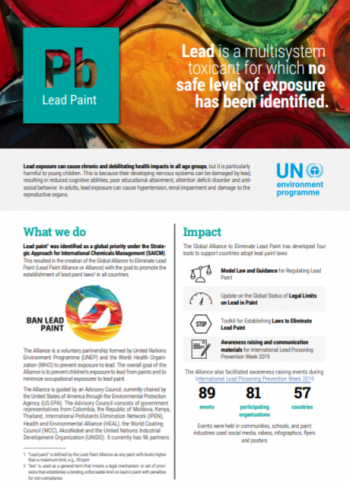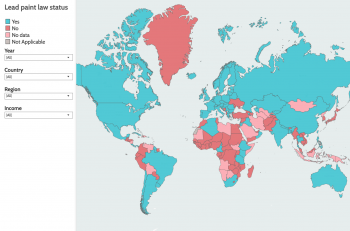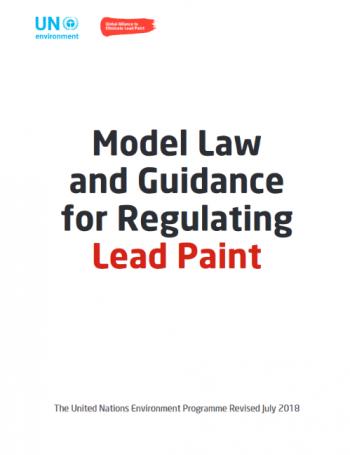Lead in paint
Model Law and Guidance for Regulating Lead Paint
About Lead in paint
Lead can be present at high levels in paint, especially in the over 100 countries that still allow the manufacture, import and sale of paints containing lead. Lead is a cumulative toxic element particularly harmful to young children and pregnant women. There is no safe level of lead exposure known, and even relatively low levels of exposure can cause serious and irreversible neurological damages, such as loss of IQ points, poor educational attainment, attention deficit disorder and anti-social behavior. In adults, lead exposure can cause hypertension, renal impairment and damage to the reproductive organs. The Institute for Health Metrics and Evaluation (IHME) has estimated that in 2017 lead exposure accounted for 1.05 million deaths due to long-term effects on health, with the highest burden in low- and middle-income countries.
Due to its versatile properties, lead has been used for millennia by humans for various types of manufacturing. In paint, lead compounds can be added as pigments, driers or as anti-corrosives to add durability, opacity and color. Lead paint can be found in homes, schools and playgrounds and is an important source of exposure to lead for children. Intact lead paint is safe. However, as the paint ages it starts to decay, and can fragment into flakes and dust that contaminate the environment and are readily swallowed by young children who typically play on the ground and frequently put their hands to their mouths.
Safer alternatives to lead compounds can be used in paints, and a number of paint companies have stopped using lead additives on a voluntary basis. The best way to protect the population from lead in paint exposure is to act now by introducing and enforcing laws that either ban or restrict the use of lead in paint. This is more cost-effective than after-the-fact efforts to remediate homes and deal with the health consequences of lead exposure. In addition, eliminating lead paint now brings future economic benefits in terms of preventing losses due to reduced productivity and avoiding the costs of the health impacts of lead .
The International Conference on Chemicals Management (ICCM) at its second session in 2009 identified lead paint as an emerging policy issue under the Strategic Approach framework. The ICCM at its third to fourth sessions continued to affirm the goal of eliminating lead paint and in 2011 mandated the creation of the Global Alliance to Eliminate Lead Paint (Lead Paint Alliance). The Lead Paint Alliance, led by the United Nations Environment Programme (UNEP) and the World Health Organization (WHO) and chaired by the US Environment Protection Agency (USEPA), aims to support the introduction of laws on phasing out the manufacture, import and sale of paints containing lead and eventually to eliminate the risks from such paint. The Strategic Approach to International Chemicals Management (SAICM) Global Environment Facility (GEF) project provides the impetus to attain the Lead Paint Alliance goal of eliminating lead paint.
Show More Show Less












